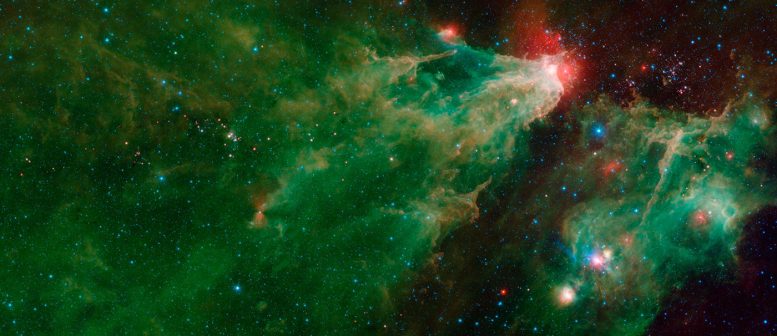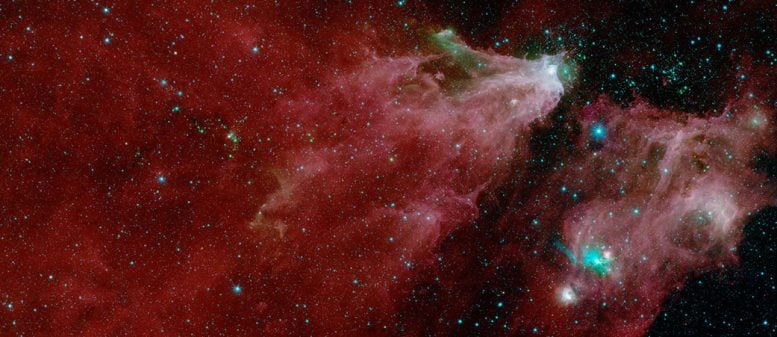Spitzer Space Telescope Captures Amazing Stellar Family Portrait

A mosaic by NASA’s Spitzer Dispute Telescope of the Cepheus C and Cepheus B regions. This inform combines recordsdata from Spitzer’s IRAC and MIPS devices.
On this aesthetic celestial mosaic taken by NASA’s Spitzer Dispute Telescope, there’s loads to glimpse, including a few clusters of stars born from the identical dense clumps of gasoline and dirt. A majority of these clusters are older than others and additional advanced, making this a generational stellar portrait.
The spacious green-and-orange delta filling many of the inform is a faraway nebula, or a cloud of gasoline and dirt in jam. Even supposing the cloud also can simply appear to streak from the realizing white build at its tip, it is far typically what stays of a magnificent elevated cloud that has been carved away by radiation from stars. The realizing space is illuminated by large stars, belonging to a cluster that extends above the white build. The white coloration is the combo of four colors (blue, green, orange and red), each and every representing a particular wavelength of infrared light, which is invisible to human eyes. Mud that has been heated by the celebs’ radiation creates the surrounding red glow.
An annotated mosaic by NASA’s Spitzer Dispute Telescope of the Cepheus C and Cepheus B regions. This inform combines recordsdata from Spitzer’s IRAC and MIPS devices.
On the left aspect of this inform, a miserable filament runs horizontally through the fairway cloud. A smattering of baby stars (the red and yellow dots) appear internal it. Identified as Cepheus C, the jam is an extremely dense focus of gasoline and dirt the build baby stars invent. The darkish vein of discipline topic will at final be dispersed by solid winds produced because the celebs change into outdated, besides to when they at final explode and die. This also can simply create an illuminated puffed-up space that will glimpse equivalent to the realizing red-and-white space on the cultured nebula’s better-exact aspect. The distance known as Cepheus C because it lies in the constellation Cepheus, that can even be stumbled on near the constellation Cassiopeia. Cepheus C is ready 6 light-years lengthy and lies about 40 light-years from the realizing build at the tip of the nebula.
A 2d aesthetic nebula can even be seen on the exact aspect of the inform, with a important particular person cluster positioned simply above it. Identified as Cepheus B, the cluster sits within about a thousand light-years of our Sun. A peek of this space the exercise of Spitzer recordsdata stumbled on that the dramatic assortment is ready 4 million to 5 million years veteran — a diminutive of older than those in Cepheus C.
In that methodology, the mosaic is a veritable household portrait, featuring infants, oldsters and grandparents of important particular person-forming regions: Stars invent in dense clouds of discipline topic, treasure the darkish vein that makes up Cepheus C. As the celebs grow, they fabricate winds that blow the gasoline and dirt outward, to invent gorgeous, illuminated nebulas treasure the realizing white build at the cease of the elevated nebula. At final, the mud and gasoline disperse, and the important particular person clusters stand by myself in jam, as with Cepheus B.
Utterly different Sights to Gain out about
The amazing facets on this inform don’t cease there.
Glance carefully for the tiny, red hourglass form simply beneath Cepheus C. That is V374 Ceph. Astronomers finding out this large important particular person have speculated that it will doubtless be surrounded by a virtually edge-on disk of darkish, dusty discipline topic. The darkish cones extending to the exact and left of the important particular person are a shadow of that disk.
The smaller nebula on the exact aspect of the inform contains two in particular attention-grabbing objects. Within the simpler-left share of the nebula, attempt to obtain a blue important particular person crowned by a tiny, red arc of light. This “runaway important particular person” is plowing through the gasoline and dirt at a instant clip, making a shock wave, or “bow shock,” in entrance of itself.
Furthermore hidden within this 2d nebula, a tiny cluster of new child stars illuminates the dense cloud of gasoline and dirt the build they shaped. This space is extra evident in the inform beneath, which makes exercise of recordsdata from only one in every of Spitzer’s devices. (The head inform contains recordsdata from two devices.) Within the inform beneath, this characteristic looks as a realizing teal splash.
A mosaic by NASA’s Spitzer Dispute Telescope of the Cepheus C and Cepheus B regions, the exercise of recordsdata from Spitzer’s IRAC instrument only. The inform on the exact is annotated to mark the space of attention-grabbing facets. Credits: NASA/JPL-Caltech
More In regards to the Photos
The 2-instrument inform became as soon as compiled the exercise of recordsdata from the Infrared Array Digicam (IRAC) and the Multiband Imaging Photometer (MIPS) all the device through Spitzer’s “cold” mission, sooner than the spacecraft’s liquid helium coolant ran out in 2009. The colors correspond with IRAC wavelengths of three.6 microns (blue), 4.5 microns (cyan), 8 microns (green) and MIPS at 24 microns (red).
The one-instrument inform reveals recordsdata from IRAC only, with colors equivalent to wavelengths of three.6, 4.5, 5.8 and 8.0 μm (shown as blue, green, orange and red).
In 2017 and 2016, excessive college students and lecturers contributed to our working out of the Cepheus C important particular person-forming space. As share of NITARP (NASA/IPAC Teacher Archive Learn Program), the students and lecturers combed through Spitzer recordsdata to establish the presence of younger stellar objects. Over two years and with the guidance of astronomer Luisa Rebull of IPAC at Caltech, the students and lecturers recognized higher than 100 such objects that hadn’t been recognized in previous analysis. Educators drawn to taking share in NITARP also can simply restful test with this plan internet space.
The Jet Propulsion Laboratory in Pasadena, California, manages the Spitzer Dispute Telescope mission for NASA’s Science Mission Directorate in Washington. Science operations are conducted at the Spitzer Science Heart at Caltech in Pasadena. Dispute operations are based at Lockheed Martin Dispute Techniques in Littleton, Colorado. Data are archived at the Infrared Science Archive housed at IPAC at Caltech. Caltech managesJPLfor NASA.







